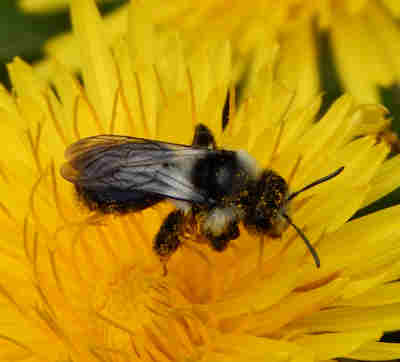Bees And Other Pollinators Love Dandelions
- and birds like them too!
Updated: 30th April 2021
Dandelions are beneficial for a wide range of pollinators, including bees, butterflies, and hover flies. They have a long flowering season – starting from early spring, dandelions supply both nectar and pollen for hungry bees and pollinators for a long period, despite the fact that they do not rely on insects to be pollinated!
The problem is, dandelions are more popular with pollinators than gardeners. Many gardeners look upon the dandelion only as an invasive, perennial weed, whilst pollinators no doubt see a most attractive and welcome food-stop!
I have a small garden, where space is precious. I want to enjoy my garden too, but part of that enjoyment comes from watching the bees and other pollinators that visit it.
On the other hand, for several years, I had an allotment, and it had many perennial “weeds”.
I
know and understand the view that dandelions compete with seedlings for soil
nourishment and water, spread very quickly, and are very difficult to keep off
your vegetable beds if they are allowed to get out of hand.
 Above: Ashy Mining Bee - Andrena cineraria on Dandelion (Taraxacum)
Above: Ashy Mining Bee - Andrena cineraria on Dandelion (Taraxacum)If you have spent a lot of time and effort, plus money on seeds, no doubt you want to see some return on your efforts – in the form of the choice of crops you planted, not a bed of dandelions (and yes, I know that dandelions are edible, but they just don’t replace carrots, peas and beans in every meal!).
So what should we do about dandelions in the garden?
Well, I can tell you what I do, but no doubt everyone’s experience is different.
As I said, I have a small garden, where space is a limited, and I want to maximise it, as well as enjoy it as a place to relax in.
 Andrena nitida - Grey-patched mining bee on dandelion
Andrena nitida - Grey-patched mining bee on dandelionI tend to allow a few dandelions to thrive, especially in spring, and more so if there is a shortage of other flowers available for the bees – perhaps because poor weather means that fewer flowers are in bloom (dandelions are brilliantly hardy, and no doubt are a life saver for bees and other insects in the early months of slim-pickings).
If I am concerned about them getting out of hand, I will remove the clocks (seed heads) and put them in the council compost bin (sorry goldfinches – you had your chance! – but I leave plenty of other seed heads for them to get at). I never use weed killers, ever. I tend to have a few dandelions in the rockery, one or two in the lawn, sometimes a few among the established raspberry canes, and that is about it. The odd one might appear behind the greenhouse.
 Bombus lapidarious queen on dandelion
Bombus lapidarious queen on dandelionI also look around the local area. I can tell you that in my immediate area, there are many, many dandelions in the verges, down in the valley, and the country lane were I walk our spaniel on a daily basis. In short, I feel I can keep control of the dandelions in favour of including other plants not represented in my local vicinity.
But what if you live in an urban area, with few dandelions around, but you do not want to have a garden covered in dandelions?
Perhaps you could allow a couple to thrive, as I do, ensuring you remove the clocks on a regular basis to prevent the seeds spreading?
 Honey bees (Apis mellifera) also enjoy feeding on dandelions
Honey bees (Apis mellifera) also enjoy feeding on dandelionsYou can also include spring flowering plants that have broad appeal for pollinators. I especially recommend pulmonaria and spring flowering heathers. Flowering shrubs provide great potential for bees, with ceanothus, berberis, rhibes and mahonia.
Do Birds Feed On Dandelions?
Yes! A variety of birds eat dandelion seeds. Red polls, siskins, bullfinches, greenfinches and goldfinches certainly do (and I'm sure there are many more). We have goldfinches around us, and I have observed them collecting the soft dandelion seed heads (clocks) –because goldfinches eat dandelion seeds, and I imagine, the soft, feathery parasol makes very useful nest material.
So.....next time you thinking of pulling up the dandelions....please spare a thought for the bees (and the birds!).
If you found this page helpful or interesting, I'd really be grateful if you would share it with others - if not this page, perhaps another, such as Gardening For Bees.
Thank you so much :) .
